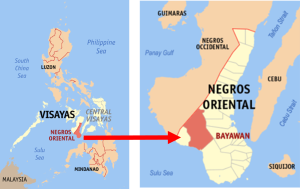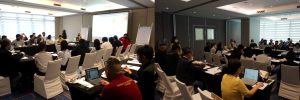In the Philippines, only 10% of wastewater is treated, and only 5% of the total population is connected to a sewer network. The rest rely on septic tanks and pit latrines and, worst, practice open defecation (Domingo and Manejar, 2021; Philippine Development Plan 2017-2022). Nature-based Solutions (NbS) can address growing water quality and sanitation concerns. Constructed Wetlands (CWs) are an example of an effective NbS for wastewater treatment and water security (UN-Habitat, 2008).
The first CWs treatment facility in the Philippines was built and is being managed by the Bayawan City Local Government Unit (LGU) in Negros Oriental (see Figure 1). Bayawan City is also called the “Agricultural Capital of Negros Oriental.” Bayawan is a component City in the 3rd Congressional District of the Province Negros Oriental. Composed of 28 barangays with a total land area of 69,908 hectares, the city is the largest in the province (Bayawan City Profile, 2022). Rural areas account for 83.1% of the city’s total land area, while urban areas constitute only 2.3% (1,573 hectares) and suburban areas amount to about 10,260 hectares or 14.7% (Bayawan City Profile, 2022). According to the 2020 Philippine Statistics Authority Census, the city’s total population is 122,747.

The major economic activities in the city are farming and fishing. These reflect the key landscape of the city, which is agricultural. The city also has an approximately 15-kilometre coastline, rich in coastal resources. In 1995, an estimated 750 Informal Settler Families (ISF) lived on the coast, which made them highly exposed and vulnerable to disasters. Furthermore, they had no access to safe water supply and sanitation facilities and thus contributed to the pollution of the coastal waters (A. Aguilar, personal communication, August 2022). The City Health Office’s records revealed a significant prevalence of illness and mortality from water-borne infections in these informal settlements (Lipkow and Münch, 2010; A. Aguilar, personal communication, August 2022). To address this, the city government bought a seven-hectare piece of land, now called the GK Fisherman’s Village, as a relocation area for the affected families and installed CWs for domestic wastewater treatment. From May 2005 to August 2006, the City Engineering Office of the Bayawan City LGU worked on the project with technical assistance provided by the German Technical Cooperation or GTZ through its Water and Sanitation Program (Lipkow and Münch, 2010). In September 2006, the CWs system was officially inaugurated. It has been continuously operated and managed by the Bayawan City LGU until now (see Figure 2, photos taken February 2023).

The Society for the Conservation of Philippine Wetlands, Inc (SCPW) and researchers from the University of the Philippines Los Baños (UPLB) conducted a case study on the operation of the CWs in Bayawan City as an NbS solution for wastewater treatment in the country, focusing on social acceptability and replicability of the said technology. This study is part of the “Integrated assessment of existing practices and development of pathways for the effective integration of nature-based water treatment in urban areas in Sri Lanka, the Philippines, and Vietnam” project funded by the Asia-Pacific Network for Global Change Research (APN).
Three (3) Focus Group Discussions (FGD) were conducted during field visits on August 16, 2022, and February 9, 2023. The FGDs included 1) block leaders of the GK Fisherman’s Village, 2) Barangay (village) officials and staff in Barangay Maninihon, and 3) Barangay officials and staff in Barangay Villareal, all from the City of Bayawan (see Figure 3).

Key Informant Interviews (KIIs) were also conducted with selected personnel involved in the operation of the CW. In addition, 270 residents from the GK Fisherman’s Village were also invited to participate in the social acceptability survey. Results showed that 94% of the survey respondents are aware of the CW and its existence in the village. Table 1 summarises the survey results on the social acceptability of the CWs in Bayawan City.

The study confirmed that CWs are a cost-effective way of treating domestic wastewater to reduce water pollution, which helps improve the community’s health. Key factors affecting social acceptability according to the result of the FGD, the KIIs, and the survey are adequate preparation, participation and involvement of the local community, awareness, trust in the implementers, a feeling of safety, and the perceived impacts and benefits for the community. Moreover, through thematic analysis, it was found that the critical aspects for the sustainability and replicability of the CW in the case of Bayawan City are strong political will, policy and funding support, cooperation of the community (social/public acceptance), the existence of a unit responsible solely for managing the operations and maintenance of the CWs, technical knowledge, and availability of land.
Regarding improvement opportunities for current and future applications, the study suggests that generating more direct benefits, especially provisioning services, which have economic value for the community, is essential to ensure the continued interest and support of local decision-makers and politicians. Currently, the community perceives the CW as beneficial only for its regulatory service, specifically for wastewater treatment.
As part of the APN project, a national consultation meeting on NbS for Wastewater Treatment was organised by the SCPW-UPLB APN Philippine Team. It was a critical step in initiating efforts to document NbS interventions and trigger discussions and actions on their effectiveness and potential for replication in the Philippines. Stakeholder inputs collected during the meeting enabled the development of a framework for NbS replication and identifying necessary policies to support NbS for wastewater treatment. It also increased the awareness, especially among decision-makers, of the potential contribution of NbS to resolving some of the pressing issues and challenges related to water quality in the country.
The meeting was held on October 7, 2022, and included 34 participants from 21 National Government Agencies (NGAs), private institutions, and academic and Civil Society Organizations (CSOs). Ms Amy Lecciones, Executive Director of SCPW, opened the event and explained the event’s objectives to the participants, many of whom are also part of the network of SCPW. The welcome address was followed by three presentations by: (1) Dr Jega V. Jegatheesan, Project Leader of the APN project and Professor from RMIT University Australia, who shared some info about the project; (2) Engineer Antonio S. Aguilar, Jr., Assistant City Engineer of Bayawan City, Negros Oriental, who made a presentation on “Nature-based solution in the Philippines: Bayawan Best Practices”; and (3) Dr Perlie P. Velasco, from the University of the Philippines Los Baños (UPLB), who presented the draft assessment framework for CWs for domestic wastewater treatment in the country. The presentations were followed by a roundtable discussion facilitated by Dr Ma. Catriona Devanadera (see Figure 4).
The round table discussions focused on the step-by-step process for establishing CWs, challenges and opportunities related to NbS-CW, key factors for replication and up-scaling, policy options and other recommendations for advancing the use of NbS for wastewater treatment in the country. Boxes 1 to 4 show the results of the roundtable discussions during the National Consultation Meeting. The project team is currently working on following up on some of the recommendations. Specifically, it is developing guidelines for establishing, operating, and maintaining CWs based on the example and the lessons learnt from the Bayawan case study. Commitments to further collaboration developed through the workshop are expected to serve as stepping-stones for following up on some of the policy-related recommendations, such as the suggestion for integrating CW in the country’s Nationally Determined Contributions (NDCs) to the Paris Agreement, among others.
| Box 1. Challenges to replicating and up-scaling NbS for wastwater treatment in the Philippines |
|---|
|
| Box 2. Opportunities for replicating and up-scaling NbS for wastewater treatment in the Philippines |
|---|
|
| Box 3. Policy options on how NbS for wastewater treatment can be pursued, replicated, and up-scaled in the Philippines. |
|---|
|
| Box 4. Other insights and recommendations on how to pursue, replicate, and up-scale NbS for wastewater treatment in the Philippines. |
|---|
|
References
Bayawan City Profile. (2022). Bayawan City Official Website. Retrieved August 18, 2022 from https://www.bayawancity.gov.ph/?mnu=1&smnu=3
Domingo, S.N. and Manejar, A.J.A. (2021). Review of Urban Wastewater Management and Clean Water Act. Discussion Paper Series 2021-46. Philippine Institute for Development Studies. http://hdl.handle.net/10419/256881
“HueMan1”. (2020). Map of the Philippines showing the location of Negros Oriental [Map]. Wikipedia. https://en.m.wikipedia.org/wiki/File:Ph_locator_negros_oriental.svg
Gonzales, M. (2006). Map of Negros Oriental showing the location of Bayawan [Map]. Wikipedia. https://en.wikipedia.org/wiki/Bayawan
Google Maps. (2023). “Bayawan City, Negros Oriental” [Map].
Lipkow, U. and Münch, E. (2010). Constructed wetland for a peri-urban housing area, Bayawan City, Philippines. Sustainable Sanitation Alliance Project. Retrieved from https://www.susana.org/en/knowledge-hub/resources-and-publications/library/details/51
National Economic and Development Authority. (2017). Philippine Development Plan 2017–2022.
UN-Habitat. (2008). Constructed Wetlands Manual. UN-Habitat Water for Asian Cities Programme.

